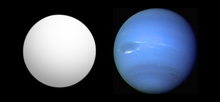
A Super-Earth is a type of exoplanet with a mass higher than Earth's, but substantially below those of the Solar System's ice giants, Uranus and Neptune, which are 14.5 and 17 times Earth's, respectively. The term "super-Earth" refers only to the mass of the planet, and so does not imply anything about the surface conditions or habitability. The alternative term "gas dwarfs" may be more accurate for those at the higher end of the mass scale, although "mini-Neptunes" is a more common term.
This page describes exoplanet orbital and physical parameters.

A hot Neptune or Hoptune is a type of giant planet with a mass similar to that of Uranus or Neptune orbiting close to its star, normally within less than 1 AU. The first hot Neptune to be discovered with certainty was Gliese 436 b in 2007, an exoplanet about 33 light years away. Recent observations have revealed a larger potential population of hot Neptunes in the Milky Way than was previously thought. Hot Neptunes may have formed either in situ or ex situ.

Kepler-5b is one of the first five planets discovered by NASA's Kepler spacecraft. It is a Hot Jupiter that orbits a subgiant star that is more massive, larger, and more diffuse than the Sun is. Kepler-5 was first flagged as the location of a possibly transiting planet, and was reclassified as a Kepler Object of Interest until follow-up observations confirmed the planet's existence and many of its characteristics. The planet's discovery was announced at a meeting of the American Astronomical Society on January 4, 2010. The planet has approximately twice the mass of Jupiter, and is about 1.5 times larger. It is also fifteen times hotter than Jupiter. Kepler-5b orbits Kepler-5 every 3.5 days at a distance of approximately 0.051 AU.

Kepler-9c is one of the first seven extrasolar planets, exoplanets, discovered by NASA's Kepler Mission, and one of at least two planets orbiting the star Kepler-9. Kepler-9c and Kepler-9b were the first exoplanets confirmed to be transiting their star. The planet's discovery was announced by the Kepler Mission team on August 26, 2010 after its initial discovery by Kepler. At the time, it was one of 700 planetary candidates noted by Kepler.

Kepler-10, formerly known as KOI-72, is a Sun-like star in the constellation of Draco that lies 607 light-years from Earth. Kepler-10 was targeted by NASA's Kepler spacecraft, as it was seen as the first star identified by the Kepler mission that could be a possible host to a small, transiting exoplanet. The star is slightly less massive, slightly larger, and slightly cooler than the Sun; at an estimated 11.9 billion years in age, Kepler-10 is almost 2.6 times the age of the Sun.

Kepler-10c is an exoplanet orbiting the G-type star Kepler-10, located around 608 light-years away in Draco. Its discovery was announced by Kepler in May 2011, although it had been seen as a planetary candidate since January 2011, when Kepler-10b was discovered. The team confirmed the observation using data from NASA's Spitzer Space Telescope and a technique called BLENDER that ruled out most false positives. Kepler-10c was the third transiting planet to be confirmed statistically, after Kepler-9d and Kepler-11g. The Kepler team considers the statistical method that led to the discovery of Kepler-10c as what will be necessary to confirm many planets in Kepler's field of view.
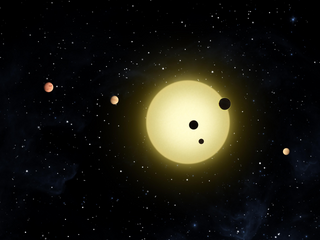
Kepler-11, also designated as 2MASS J19482762+4154328, is a Sun-like star slightly larger than the Sun in the constellation Cygnus, located some 2,150 light years from Earth. It is located within the field of vision of the Kepler spacecraft, the satellite that NASA's Kepler Mission uses to detect planets that may be transiting their stars. Announced on February 2, 2011, the star system is among the most compact and flattest systems yet discovered. It is the first discovered case of a star system with six transiting planets. All discovered planets are larger than Earth, with the larger ones being about Neptune's size.

Kepler-11b is an exoplanet discovered around the star Kepler-11 by the Kepler spacecraft, a NASA-led mission to discover Earth-like planets. Kepler-11b is less than about three times as massive and twice as large as Earth, but it has a lower density, and is thus most likely not of Earth-like composition. Kepler-11b is the hottest of the six planets in the Kepler-11 system, and orbits more closely to Kepler-11 than the other planets in the system. Kepler-11b, along with its five counterparts, form the first discovered planetary system with more than three transiting planets—the most densely packed known planetary system. The system is also the flattest known planetary system. The discovery of this planet and its five sister planets was announced on February 2, 2011, after follow-up investigations.

Kepler-11c is an exoplanet discovered in the orbit of the Sun-like star Kepler-11 by the Kepler spacecraft, a NASA telescope aiming to discover Earth-like planets. It is the second planet from its star, and is most likely a water planet with a thin hydrogen–helium atmosphere. Kepler-11c orbits Kepler-11 every 10 days, and has an estimated density twice that of pure water. It is estimated to have a mass thirteen times that of Earth and a radius three times that of Earth. Kepler-11c and its five sister planets form the first discovered system with more than three transiting planets. The Kepler-11 system also holds the record of being the most compact and the flattest system discovered. Kepler-11c and the other Kepler-11 planets were announced to the public on February 2, 2011, and was published in Nature a day later.

Kepler-11e is an exoplanet discovered in the orbit of the sunlike star Kepler-11. It is the fourth of six planets around Kepler-11 discovered by NASA's Kepler spacecraft. Kepler-11e was found by using the transit method, in which the dimming effect that a planet causes as it crosses in front of its star is measured. Kepler-11e is most likely a gas giant like Neptune, having a density that is less than that of Saturn, the least dense planet in the Solar System. Its low density can probably be attributed to a large hydrogen and helium atmosphere. Kepler-11e has a mass eight times of Earth's mass and a radius 4.5 times that of Earth. The planet orbits its star every 31 days in an ellipse that would fit within the orbit of Mercury. Kepler-11e was announced on February 2, 2011 with its five sister planets after it was confirmed by several observatories.

Kepler-11f is an exoplanet discovered in the orbit of the sun-like star Kepler-11 by NASA's Kepler spacecraft, which searches for planets that transit their host stars. Kepler-11f is the fifth planet from its star, orbiting one quarter of the distance of the Earth from the Sun every 47 days. It is the furthest of the first five planets in the system. Kepler-11f is the least massive of Kepler-11's six planets, at nearly twice the mass of Earth; it is about 2.6 times the radius of Earth. Along with planets d and e and unlike the two inner planets in the system, Kepler-11f has a density lower than that of water and comparable to that of Saturn. This suggests that Kepler-11f has a significant hydrogen–helium atmosphere. The Kepler-11 planets constitute the first system discovered with more than three transiting planets. Kepler-11f was announced to the public on February 2, 2011, after follow-up investigations at several observatories. Analysis of the planets and study results were published the next day in the journal Nature.
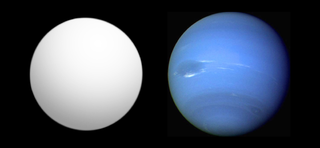
Kepler-11g is an exoplanet discovered in the orbit of the sunlike star Kepler-11 by the Kepler spacecraft, a NASA satellite tasked with searching for terrestrial planets. Kepler-11g is the outermost of the star's six planets. The planet orbits at a distance of nearly half the mean distance between Earth and the Sun. It completes an orbit every 118 days, placing it much further from its star than the system's inner five planets. Its estimated radius is a little over three times that of Earth, i.e. comparable to Neptune's size. Kepler-11g's distance from the inner planets made its confirmation more difficult than that of the inner planets, as scientists had to work to exhaustively disprove all reasonable alternatives before Kepler-11g could be confirmed. The planet's discovery, along with that of the other Kepler-11 planets, was announced on February 2, 2011. According to NASA, the Kepler-11 planets form the flattest and most compact system yet discovered.

Kepler-9d is a planet in orbit around the Sun-like star Kepler-9. Initially discovered by Kepler spacecraft, a terrestrial planet-searching satellite built and operated by NASA, Kepler-9d is most likely a Super-Earth, with an estimated radius approximately 60% larger than that of Earth's, although its exact mass cannot be determined. Kepler-9d orbits Kepler-9 every 1.56 days at a distance of .0273 AU from its star, an extremely close distance. Although Kepler-9d is the closest planet to its star in its system, it is named Kepler-9d instead of Kepler-9b because two gas giants, Kepler-9b and Kepler-9c, were confirmed first. The original studies into the system first suggested that Kepler-9d might be a planet, but a follow-up investigation made by the Kepler team later confirmed that it was; the confirmation of Kepler-9d as a planet was made public with the team's paper, which was published in the Astrophysical Journal on January 1, 2011. The team used telescopes at the W.M. Keck Observatory in Hawaii to follow up on the Kepler space telescope's initial discovery.
Kepler-40b, formerly known as KOI-428b, is a hot Jupiter discovered in orbit around the star Kepler-40, which is about to become a red giant. The planet was first noted as a transit event by NASA's Kepler spacecraft. The Kepler team made data collected by its satellite publicly available, including data on Kepler-40; French and Swiss astronomers used the equivalent to one night of measurements on the SOPHIE échelle spectrograph to collect all the data needed to show that a planet was producing the periodic dimming of Kepler-40. The planet, Kepler-40b, is twice the mass of Jupiter and slightly larger than it in size, making it as dense as Neptune. The planet is also nearly thirteen times hotter than Jupiter and orbits five times closer to its star than Mercury is from the Sun.
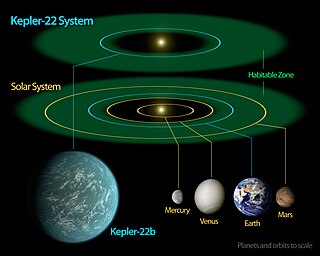
Kepler-22b is an exoplanet orbiting within the habitable zone of the Sun-like star Kepler-22. It is located about 640 light-years from Earth in the constellation of Cygnus. It was discovered by NASA's Kepler Space Telescope in December 2011 and was the first known transiting planet to orbit within the habitable zone of a Sun-like star, where liquid water could exist on the planet's surface. Kepler-22 is too dim to be seen with the naked eye.
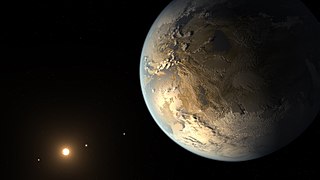
Kepler-186f is an Earth-sized exoplanet orbiting within the habitable zone of the red dwarf star Kepler-186, the outermost of five such planets discovered around the star by NASA's Kepler spacecraft. It is located about 580 light-years from Earth in the constellation of Cygnus.

HD 219134 b is one of at least five exoplanets orbiting HD 219134, a main-sequence star in the constellation of Cassiopeia. HD 219134 b has a size of about 1.6 R🜨, and a density of 6.4 g/cm3 and orbits at 21.25 light-years away. The exoplanet was initially detected by the instrument HARPS-N of the Italian Telescopio Nazionale Galileo via the radial velocity method and subsequently observed by the Spitzer telescope as transiting in front of its star. The exoplanet has a mass of about 4.5 times that of Earth and orbits its host star every three days. In 2017, it was found that the planet likely hosts an atmosphere.

Kepler-56b (KOI-1241.02) is a hot Neptune—a class of exoplanets—located roughly 3,060 light-years away. It is somewhat larger than Neptune and orbits its parent star Kepler-56 and was discovered in 2013 by the Kepler Space Telescope.

K2-288Bb is a super-Earth or mini-Neptune exoplanet orbiting in the habitable zone of K2-288B, a low-mass M-dwarf star in a binary star system in the constellation of Taurus about 226 light-years from Earth. It was discovered by citizen scientists while analysing data from the Kepler spacecraft's K2 mission, and was announced on 7 January 2019. K2-288 is the third transiting planet system identified by the Exoplanet Explorers program, after the six planets of K2-138 and the three planets of K2-233.
